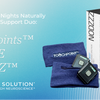Do Stress Relief Devices Work?

By Nathan Hageman, MD. Ph.D.
Stress is a growing health issue for society today. In fact, according to The American Institute of Stress, 77% of people experience stress that affects their physical health and 73% have stress that impacts their mental health. With the wide reach of its impact, it’s not surprising there been many advancements in the treatment of stress, including wearable stress relief devices. But do these actually work? And if so, how? Let's start by exploring why we need to manage our stress.
Stress and related disorders are responsible for a high degree of disability worldwide. Workplace-related stress is estimated to be a significant economic burden, resulting in workers with “more workdays lost, increased impairment at work, and a higher use of healthcare services” (Kalia, M. et al., 2002). In addition, in the near future, the healthcare-related burden associated with stress and related disorders is estimated to rival that of current major cardiovascular pathologies, such as heart attack, hypertension, and stroke.
Stress - the good and the bad
Over the short-term, stress can be beneficial. It can heighten our senses, shorten reaction times, increase focus and attention, and improve recall and performance; however, these things do come with a cost, especially when stress is chronic. The effects of stress response are mediated by “stress hormones”, most notably epinephrine and cortisol, which increase heart rate, blood pressure, and blood sugar, and constrict peripheral blood flow. Chronically, over a long period, this can lead to pathological changes in the cardiovascular system that increase the risk of heart attack, diabetes, and stroke. High stress levels are also associated with an increased risk of developing certain psychiatric conditions, especially depressive and anxiety disorders (e.g., major depressive disorder, generalized anxiety disorder).
Stress and the Nervous System
The unconscious physical and emotional reactions we have to stress are manifested by a separate set of neural fiber pathways running throughout the body called the autonomic nervous system (ANS). The ANS governs the automatic physiological changes that occur in response to stimuli. It is functionally and structurally divided into two opposing components:
- the sympathetic nervous system responsible for our “fight or flight” response that is stimulated in response to high stress situations, perceived danger, or trauma. It is physiologically characterized by an increase in pulse, blood pressure, and blood sugar, and a reduction in peripheral blood flow.
- the parasympathetic nervous system opposes the “fight or flight” response and promotes calm, digestion, rest, and sleep. It is physiologically characterized by a decrease in pulse, blood pressure, and blood sugar, with an increase in peripheral blood flow.
Each of these components of the ANS has a “tone,” or a baseline level of activity. The intensity with which we experience the symptoms of stress (e.g., sweaty palms, stomachache, anxiety) at any particular moment depends on the balance between these two opposing components of the ANS. As one component increases, the other decreases. In particular, stress increases sympathetic tone and decreases parasympathetic tone. Relief of stress would then logically be expected if parasympathetic tone was increased which would decrease sympathetic tone.
The brain centers that control both parts of the ANS are located mainly in the brainstem and neural fibers extend from there throughout the body to influence multiple body systems. These control centers can be highly influenced by fibers descending from higher regions of the brain. For example, recall of a stressful traumatic memory may stimulate the “fear-center” of the brain (called the amygdala) that has widespread descending input into the ANS control centers and can significantly increase sympathetic tone. Therefore, a person’s experiences, memories, and past traumas can be hard-wired to their stress response.
How do wearables relieve stress?
TouchPoints use a patented technology called bilateral alternating somatosensory tactile stimulation (BLAST), which is derived from an established, and well-validated psychotherapeutic technique for treating post-traumatic stress disorder, called eye movement desensitization and reprocessing (EMDR). EMDR works by a series of alternating left-to-right pattern of discrete visual or somatosensory stimuli performed by a therapist while at the same time the patient focuses on a specific traumatic memory. This “rewires” that specific traumatic memory reducing both the emotional and physical manifestations of the stress response associated with that memory.
This is accomplished in two ways:
(1) This pattern of stimulation increases parasympathetic tone. This can be seen objectively on EEG activity that mimic patterns associated with deep meditation and sleep and in the reduction of cortisol levels.
(2) This pattern of stimulation rewires stress triggers by encouraging the establishment of more widespread, interhemispheric connections with predominately cortical cognitive networks.
BLAST takes the stimulatory pattern from EMDR and allows the user to administer it in a self-directed manner. BLAST does not require a therapist’s supervision and does not require a subject to choose trigger memories to process. BLAST is the basis of behind TouchPoints, wearable stress relief devices worn around subject’s wrists (dimensions: 25 mm x 37 mm x 33 m; weight:14 grams) that provide vibratory stimulation (10 – 55 Hz) in a bilateral alternating pattern.

Research Validation
Do TouchPoints really work? Results from multiple published peer-reviewed research studies have shown that TouchPoints reduces both emotional and physical aspects of the stress response.
QUANTITATIVE ELECTROENCEPHALOGRAM STUDY
Our study involving quantitative electroencephalogram data clearly shows a reduction in brain wave activity in areas associated with anxiety (beta waves). TouchPoints’ patented BLAST (bi-lateral alternating stimulation-tactile technology) alters the body’s “fight or flight” response caused by stress. The wearables emit vibrations that disengage your standard stress response which can impact your performance and health.
And the results have shown to be life changing. This unique process of shifting from one brain area to another has been proven to create new behavior patterns that lessen your reaction to stress over time.
Studies have also shown TouchPoints' impact on cortisol levels, a hormone the mediates the stress response.

Change in cortisol levels between time points for the treatment (active) group and the control (placebo) group. Data are expressed as mean and SEM. (*p<0.05, ****p<0.0001) (TPC; TouchPoint Challenge) [excerpt from Leal-Junior et al., 2019].
So, do stress relief devices work? As research indicates, TouchPoints can significantly reduce the negative impacts of stress with multiple validated studies showing their efficacy. And by reducing stress, they are able to help improve lives by increasing focus, improving sleep and enhancing performance.
Try TouchPoints risk-free for 30-days. If they don't work for you, send them back for a full refund.
-
Posted in
Anxiety, Health, Stress, Work Stress




